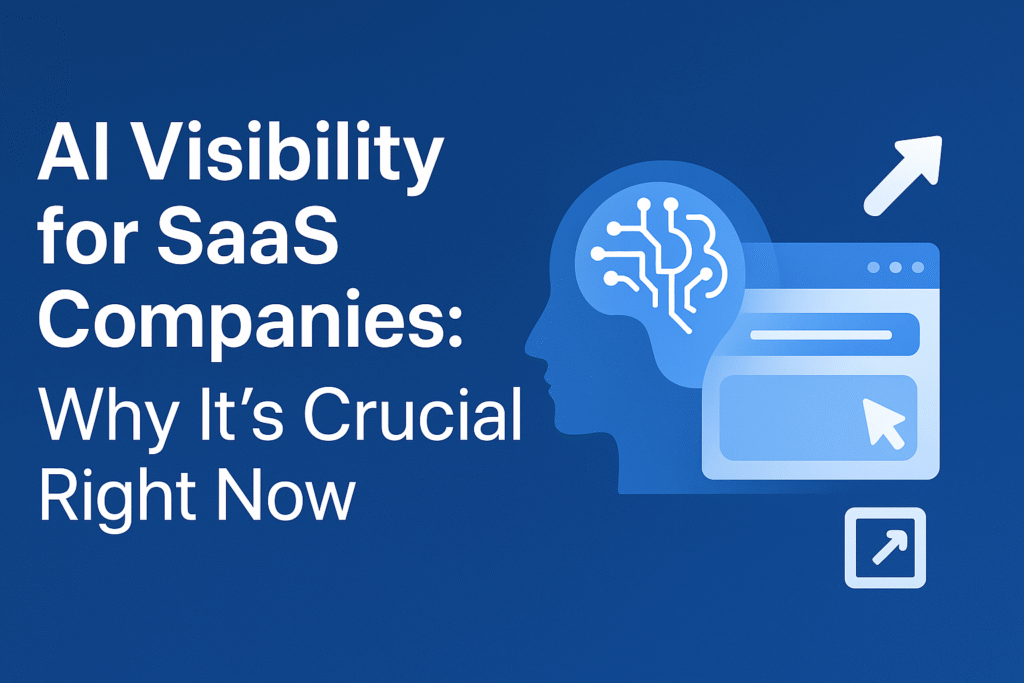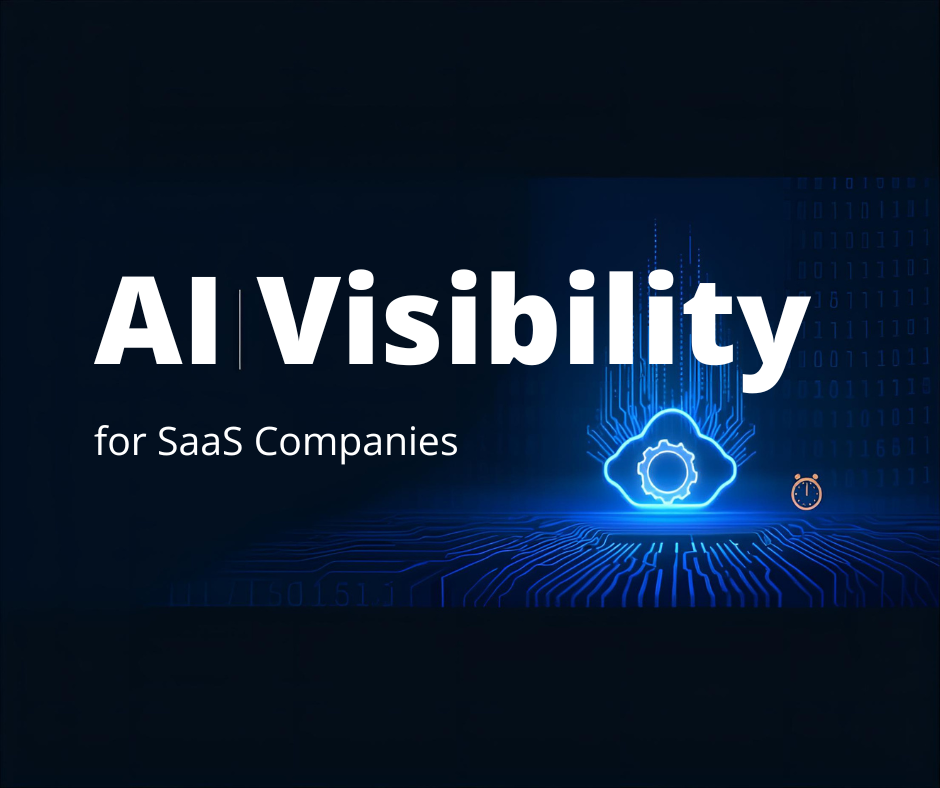Introduction: The New Era of AI Visibility
In 2025, the way people discover SaaS products is undergoing a massive transformation. Traditional search engines are no longer the only gateways to your potential customers. AI-driven tools like Google’s Search Generative Experience (SGE), ChatGPT, and Perplexity AI are now shaping how users find, evaluate, and choose software solutions.
For SaaS founders and marketing teams, this shift introduces a new frontier: AI visibility — the ability for your brand, content, and products to appear within AI-generated search results, summaries, and recommendations.
In this article, we’ll explore why AI visibility has become a mission-critical part of SaaS marketing, how it impacts your brand’s reach and revenue, and what strategies your business should adopt right now to stay ahead of the curve.
The Shift from SEO to AI Visibility
For over two decades, SaaS marketing has revolved around search engine optimization (SEO). Ranking high on Google meant traffic, leads, and growth. But AI has changed how search works.
When users now type queries like “best CRM for small businesses” or “top AI writing tools for startups”, they often receive AI-generated summaries instead of a traditional list of blue links. These summaries pull information from multiple authoritative sources and present the best possible recommendations instantly — often naming specific SaaS products.
That’s where AI visibility becomes critical. Even if your site ranks high organically, if your SaaS isn’t mentioned or referenced in AI-generated responses, you’re invisible in the new discovery journey.
Simply put: SEO gets you seen by search engines. AI visibility gets you seen by users before they even click.
What Exactly Is AI Visibility?
AI visibility refers to your brand’s presence and recognition within generative AI search results, conversational assistants, and AI-powered recommendations.
When a user asks ChatGPT, “What’s the best email automation tool for SaaS founders?”, and your product name appears in the generated response — that’s AI visibility.
Unlike traditional SEO visibility, AI visibility depends on:
- How well your brand is understood semantically by AI systems.
- How often your brand is mentioned across trusted sources.
- How your structured data helps AI interpret your offerings.
In essence, AI visibility isn’t about ranking in the top 10. It’s about being part of the answer.
Why AI Visibility Matters for SaaS Companies in 2025

a. AI Shapes Early Purchase Decisions
Users are relying on AI assistants to research SaaS tools faster. These assistants summarize reviews, compare pricing, and make tailored suggestions — long before a user visits your website. If your product doesn’t appear in those recommendations, you’re missing the earliest and most valuable stage of buyer intent.
b. Increased Brand Trust
When AI systems consistently mention your brand, it reinforces credibility. For example, if ChatGPT or Google SGE frequently references your SaaS in response to relevant queries, users begin to associate your brand with authority and trustworthiness.
c. Competitive Advantage
The race for AI visibility is still early. Many SaaS marketers haven’t optimized for it yet. Positioning your company now gives you a first-mover advantage — allowing your brand to dominate AI mentions while competitors catch up.
d. Long-Term Discoverability
Just as SEO built long-term traffic pipelines, AI visibility builds future-proof discoverability. As more platforms integrate generative AI, your SaaS will remain accessible through AI ecosystems, not just search results.
Key Factors That Influence AI Visibility
To improve AI visibility, you must understand how generative systems interpret and recommend SaaS brands. Here are the core factors:
a. Semantic Relevance
AI models rely on context and meaning, not just keywords. Optimize your SaaS content around user intent and solution-driven topics (e.g., “automate customer onboarding” instead of “onboarding software”).
b. Structured Data & Entity Optimization
Structured data (Schema markup) helps AI systems identify what your product is, what category it belongs to, and who it serves. Mark up pricing, reviews, FAQs, and product details. Create Wikipedia-style clarity around your brand’s purpose and positioning.
c. Brand Authority
AI systems pull data from trusted, widely-cited sources. If your SaaS is mentioned across reputable review sites, directories, and niche publications, AI is more likely to include you in its summaries.
d. Content Authenticity
AI prefers original, well-cited, and experience-based content. Prioritize EEAT (Experience, Expertise, Authoritativeness, Trustworthiness) principles. Publish expert-led content, customer case studies, and transparent product comparisons.
Strategies to Improve Your SaaS Company’s AI Visibility
Here’s how to position your SaaS brand to get discovered by AI-driven search and recommendation systems:
1. Optimize for AI Search (SGE, ChatGPT, Perplexity AI, and More)
- Create answer-based content that directly responds to generative search patterns (e.g., “best CRM for remote teams 2025”).
- Use structured headers, bullet points, and short summaries to make your content easily parseable by AI.
- Focus on problem-solution-outcome content structures that mirror conversational AI responses.
2. Adopt Conversational SEO
- Write content that mimics how users talk to AI assistants.
- Use question-based titles and natural language (e.g., “How can SaaS startups reduce churn with automation?”).
- Add FAQ sections optimized for featured snippets and AI summaries.
3. Strengthen Your Brand Presence Across the Web
- List your product on SaaS directories like G2, Capterra, and Product Hunt.
- Publish guest posts on industry-leading platforms to build external authority.
- Encourage customer reviews and mentions to feed positive signals to AI models.
4. Implement Product Schema and Review Markup
- Use Product, Organization, and FAQ Schema to provide machine-readable context.
- Include aggregateRating and offers properties for pricing transparency.
- Mark up demo pages and feature comparisons to help AI interpret your product scope accurately.
5. Leverage AI Integrations
If possible, integrate your SaaS product directly into AI ecosystems:
- Develop ChatGPT plugins or API integrations.
- List your app on AI tool directories or automation marketplaces.
- Build AI-ready documentation to make your product easier for AI to understand and reference.
Measuring Your AI Visibility
Tracking AI visibility is still a developing field, but several metrics and methods can help you gauge progress:
1. AI Search Mentions
Regularly test prompts related to your SaaS niche in ChatGPT, Google SGE, or Perplexity AI. Track whether your brand is being referenced.
2. Brand Mentions in Generative Summaries
Use tools like Google Alerts, Brand24, or Mention to track AI-generated summaries or quotes referencing your SaaS.
3. SGE Impression Tracking
Monitor SGE-specific impressions through Google Search Console (as SGE data becomes more accessible).
4. Referral Traffic from AI-Powered Channels
Watch for traffic from platforms like ChatGPT Browse, Perplexity.ai, or Microsoft Copilot. These sources indicate users are discovering your brand through AI systems.
Case Study Example: How Notion Built AI Visibility Early
When Notion, the productivity SaaS, launched new AI features in 2023, its visibility skyrocketed across generative platforms.
- ChatGPT often referenced Notion as an example when users asked about “AI productivity tools.”
- Google SGE featured Notion in AI summaries for “best AI note-taking software.”
- Review sites and YouTube creators frequently mentioned Notion, boosting its AI credibility.
The takeaway?
Notion’s dominance wasn’t accidental — it came from consistent brand mentions, clear product positioning, and AI-integrated product updates.
For emerging SaaS companies, replicating this approach can rapidly build AI recognition and trust.
The Future of SaaS Marketing in the AI Era
AI isn’t just changing how SaaS products are found — it’s redefining the entire buyer journey.
- Discovery: Users find SaaS tools via AI recommendations rather than ads or blogs.
- Evaluation: AI assistants compare features and pricing automatically.
- Decision: Personalized AI guidance shortens the buyer cycle.
The SaaS companies that will dominate the next decade are those that embrace AI Search visibility as a core growth strategy — not an afterthought.
By aligning your content, data, and brand presence with how AI understands and recommends products, you’ll secure a place in the evolving AI-driven ecosystem.
Conclusion
AI visibility is not a buzzword — it’s the new currency of SaaS growth. The companies that act now will shape how customers discover, evaluate, and trust software in the AI-first era.
If your SaaS isn’t visible in AI-generated responses, you’re missing the first and most influential stage of customer intent.
At Search Engine Star, we help SaaS companies adapt their SEO and content strategies to perform across AI-powered search, ensuring they remain visible, relevant, and recommended in the new age of discovery.
Want to find out if your brand is visible in AI search?
Get your free AI Search Visibility Audit from Search Engine Star today and see where you stand in Google SGE, ChatGPT, and other AI platforms.

Joseph is an SEO Specialist and the founder of Search Engine Star, a results-driven SEO agency dedicated to helping businesses boost visibility, rank higher, and grow through smart search strategies. With years of experience in eCommerce SEO, AI-driven optimization, and SEO copywriting, Joseph has helped brands increase organic traffic and secure top spots in Google’s AI Overviews and featured snippets.

